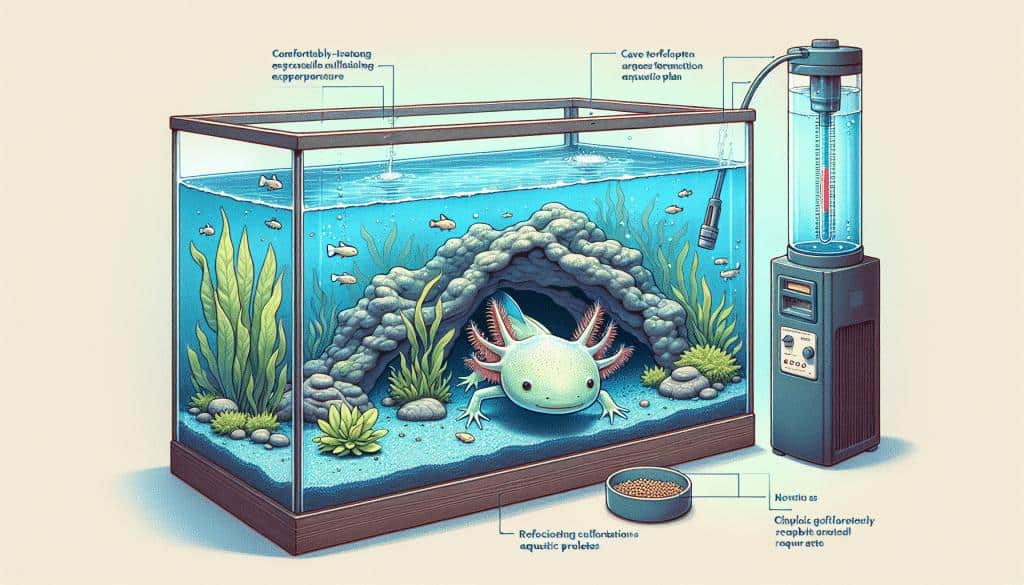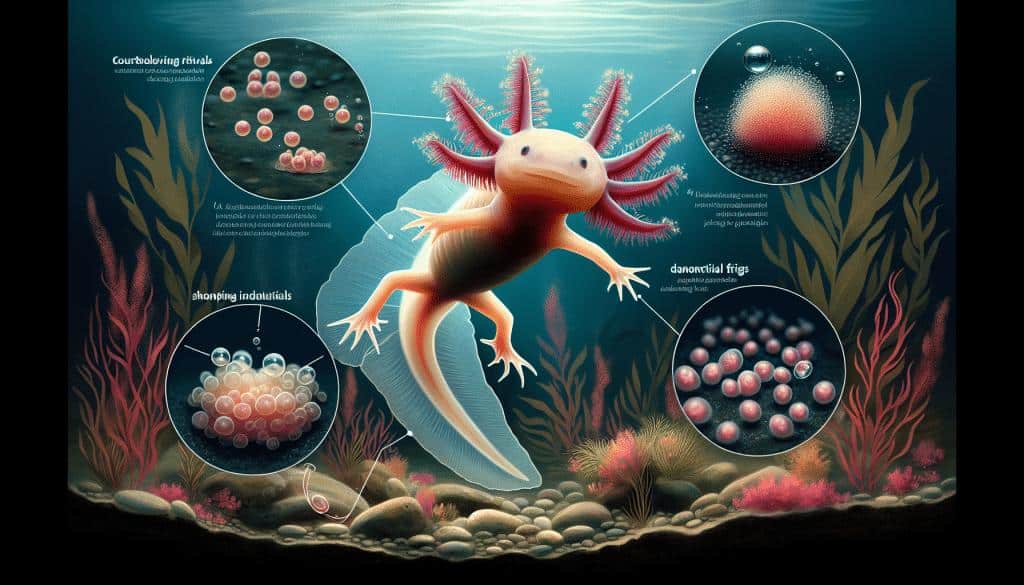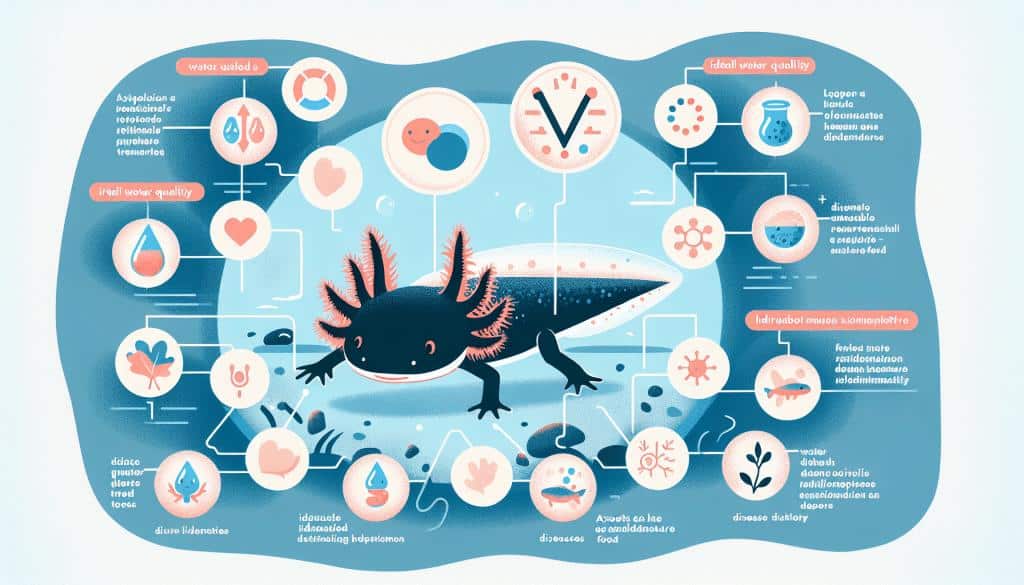You have recently become the proud owner of an adorable axolotl, and now you’re eager to provide it with a comfortable and thriving habitat. In order to ensure the well-being and happiness of your new aquatic companion, it is crucial to create the perfect axolotl tank setup. By understanding the specific needs of these unique creatures and implementing the necessary elements such as temperature control, suitable substrate, and hiding spots, you can create an environment where your axolotl can truly thrive and flourish.

Understanding Axolotl Requirements
Origins and Natural Habitat
Axolotls, also known as the Mexican Walking Fish, are unique and fascinating creatures native to the lakes and canals of Mexico. They are amphibians belonging to the family Ambystomatidae and are specifically found in the Xochimilco and Chalco regions. In their natural habitat, axolotls thrive in cool, freshwater environments with abundant vegetation and slow-moving or stagnant water. Understanding their origins and natural habitat is vital in creating a suitable and thriving environment for these enchanting creatures.
Physical Characteristics and Behavior
Axolotls possess distinctive physical characteristics that set them apart from other amphibians. They have elongated bodies, with feathery external gills that extend from the back of their heads. These gills serve a vital purpose, allowing them to extract oxygen directly from the water they inhabit. Axolotls come in a variety of colors, including shades of white, brown, and black, and their coloration can even change depending on factors such as stress and light exposure.
When it comes to behavior, axolotls are known for their calm nature. They are primarily active during the night and spend most of their day resting or burrowing in the substrate. While they may not be the most energetic of creatures, they do exhibit occasional bursts of activity, especially during feeding or when exploring their surroundings. It is essential to create an environment that meets their behavioral needs, allowing them to feel secure and comfortable.
Water Temperature and Quality Needs
Maintaining appropriate water temperature and quality is crucial for the health and well-being of axolotls. These amphibians are cold-water species and require temperatures between 16-18°C (60-64°F) to thrive. A reliable aquarium thermometer is a must-have to monitor and regulate the water temperature consistently.
Axolotls are sensitive to certain water parameters, such as pH level and hardness. The ideal pH range for axolotls is between 6.5 and 7.5, while water hardness should be kept around 100-200 parts per million (ppm). It is important to regularly test the water using aquarium test kits to ensure these parameters remain within the recommended range.
Dietary Essentials
When it comes to their diet, axolotls are carnivorous and primarily feed on live or frozen food. Their diet includes small invertebrates, such as bloodworms, brine shrimp, daphnia, and small earthworms. It is crucial to provide a varied diet to ensure they receive all the necessary nutrients for their growth and overall health. Feeding axolotls once every 1-2 days is sufficient, while avoiding overfeeding is essential to prevent obesity and water quality issues.
Tank Size and Specifications
Minimum Tank Size for Axolotls
Providing an adequately sized tank is essential for the well-being of your axolotls. The minimum recommended tank size for a single axolotl is 20 gallons. This ensures there is sufficient swimming space and allows for proper filtration and maintenance. However, it is always beneficial to provide a larger tank whenever possible.
The Benefits of a Larger Tank
Opting for a larger tank has numerous advantages for axolotls. A larger tank provides more room for the axolotls to swim, explore, and exhibit natural behaviors comfortably. It also helps dilute any potential waste and ensures water quality remains stable. Additionally, a larger tank offers more surface area, which aids in oxygen exchange, creating a healthier environment for your axolotls.
Glass vs. Acrylic Tanks
When selecting a tank material, both glass and acrylic options are available. Glass tanks offer excellent clarity and are more resistant to scratches, making them ideal for long-term use. On the other hand, acrylic tanks are lighter and less prone to breakage, making them a suitable choice for those concerned about weight or with limited space. Ultimately, the choice between glass and acrylic comes down to personal preference and specific requirements.
Tank Shape and Design Considerations
Choosing the right tank shape and design is crucial for axolotls, ensuring they can move and navigate comfortably. A rectangular tank is generally recommended as it provides ample space for swimming and allows even water distribution. Avoid tanks with sharp or curved corners, as axolotls are prone to getting stuck and injuring themselves. Additionally, consider the height of the tank, as axolotls are bottom-dwelling animals and do not benefit from excessive depth.
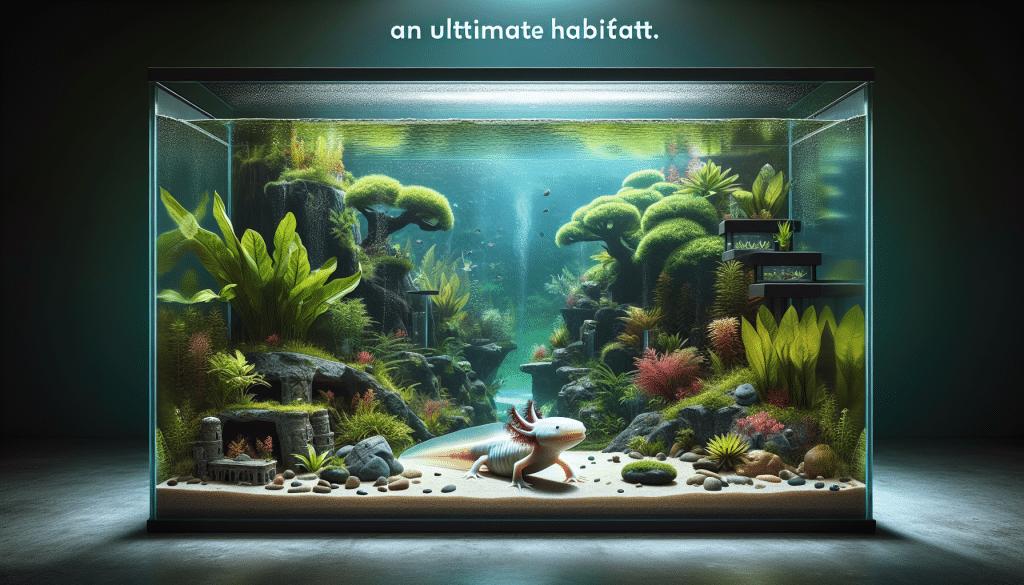
Water Parameters and Quality
Ideal Temperature Range
Maintaining the right water temperature is vital for axolotls. The ideal temperature range for these amphibians falls between 16-18°C (60-64°F). Axolotls are cold-water species and are highly sensitive to temperature fluctuations. Using a reliable aquarium heater and thermometer is essential to monitor and regulate the water temperature within this range consistently.
pH Level and Hardness
Axolotls are sensitive to changes in pH level and water hardness. The recommended pH range for axolotls is between 6.5 and 7.5, while water hardness should be maintained around 100-200 ppm. Regularly testing the water using aquarium test kits allows you to monitor these parameters and make adjustments when necessary.
Cycling the Tank Before Introduction
Before introducing axolotls to their new tank, it is crucial to cycle the aquarium. Cycling refers to establishing beneficial bacteria colonies that aid in the breakdown of harmful ammonia and nitrite, which are produced by fish waste and excess food. This process typically takes several weeks and can be achieved through methods like fishless cycling or using a bacterial starter product. Properly cycling the tank ensures a stable and healthy environment for your axolotls.
Water Change Frequency and Volume
Regular water changes play a crucial role in maintaining optimal water quality for axolotls. A 20% water change once a week is generally recommended, although this can vary depending on factors such as tank size, bioload, and water parameters. Ensure the replacement water is properly conditioned with a water conditioner to remove chlorine, chloramines, and heavy metals that may harm your axolotls.
Filtration System
Types of Filters Suitable for Axolotl Tanks
Selecting the right filtration system is vital for maintaining a clean and healthy environment for axolotls. The two most common types of filters suitable for axolotl tanks are sponge filters and canister filters. Sponge filters are gentle and provide mechanical and biological filtration, effectively removing debris and cultivating beneficial bacteria. Canister filters offer additional filtration options, including chemical filtration, and are ideal for larger tanks or tanks with a higher bioload.
Importance of a Low Flow Rate
Axolotls are not strong swimmers and are easily stressed by strong water currents. Therefore, it is crucial to choose a filter with a low flow rate to ensure they can comfortably navigate the tank without excessive exertion. This can be achieved by adjusting the flow rate of the filter or using a spray bar attachment to distribute the water flow more evenly.
How to Cycle Your Filter
Cycling the filter is an essential step in establishing a healthy and efficient filtration system. To cycle the filter, you can add a small piece of filter media from an established aquarium or use a bacterial supplement to kickstart the growth of beneficial bacteria. Regular monitoring of water parameters during the cycling process will help ensure ammonia and nitrite levels remain at zero, indicating the filter is fully cycled and ready to support your axolotls.
Cleaning and Maintenance
Regular cleaning and maintenance of the filtration system are necessary to keep it functioning optimally. This includes tasks such as rinsing or replacing filter media, cleaning intake and outflow tubes, and checking the impeller for any obstructions. It is essential to follow the manufacturer’s guidelines for cleaning and maintenance, as each filtration system may have specific requirements.
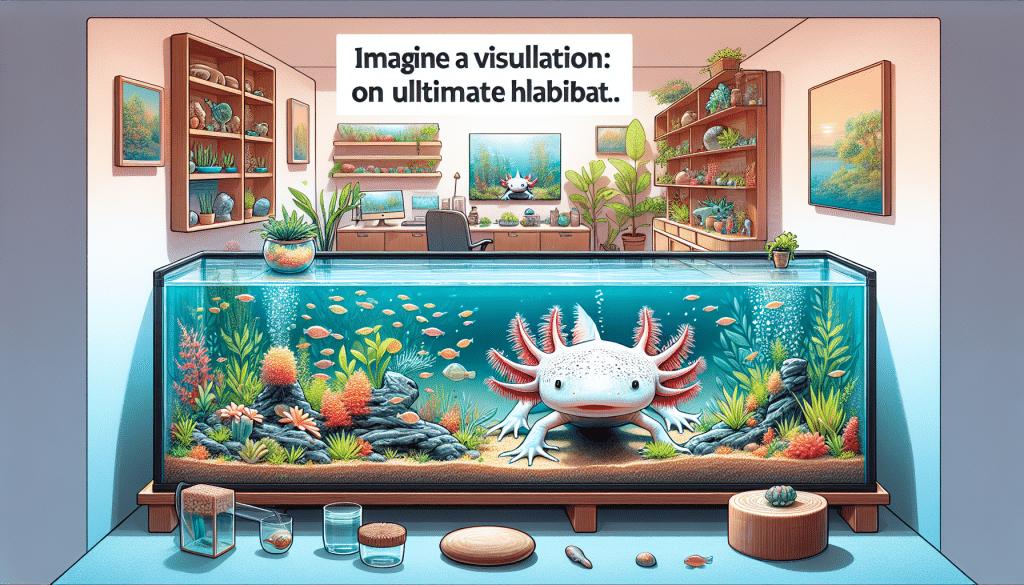
Substrate Selection
Safe Substrate Options
Choosing the right substrate is essential in creating a suitable habitat for axolotls. Safe substrate options include fine sand, smooth gravel, or bare-bottom tanks. Fine sand is a popular choice as it allows axolotls to exhibit their natural burrowing behavior without the risk of impaction. Smooth gravel can also be used, but it must be carefully selected to prevent any sharp edges that could harm their delicate skin.
Risks of Impaction with Certain Substrates
Certain substrates, such as large gravel or sharp-edged decorative rocks, pose a risk of impaction for axolotls. Impaction occurs when axolotls accidentally ingest substrate particles during feeding or exploration, leading to digestive issues and potential blockages. To minimize the risk of impaction, it is crucial to choose substrates that are too small to be ingested or opt for a bare-bottom tank setup.
Bare-Bottom vs Substrate Tanks
Deciding between a bare-bottom or substrate tank setup depends on personal preference and the specific needs of your axolotls. Bare-bottom tanks offer easier maintenance and cleaning, as waste and uneaten food are easily visible and can be quickly siphoned out. On the other hand, substrate tanks provide a more natural environment, allowing axolotls to exhibit their natural behaviors and explore their surroundings.
How to Clean Tank Substrate
If you opt for a substrate tank setup, regular cleaning is necessary to maintain water quality and prevent the buildup of waste. Using a siphon or aquarium vacuum, carefully vacuum the substrate during water changes to remove any debris or uneaten food. Be cautious not to disturb the substrate too much, as axolotls rely on it for hiding and burrowing.
Tank Decor and Enrichment
Safe Plants and Decorations
Incorporating safe plants and decorations in the axolotl tank provides not only visual appeal but also enrichment for these amphibians. Safe aquarium plants, such as Java fern, Anubias, and Marimo moss balls, offer natural cover and help maintain water quality by absorbing excess nutrients. Decorations should be carefully selected to avoid sharp edges or small parts that may harm your axolotls.
Creating Hiding Places
Axolotls are naturally shy and prefer having hiding places to feel secure in their environment. This can be achieved by incorporating various types of decorations, such as caves, PVC pipes, or even large pieces of driftwood. These hiding places allow axolotls to retreat and rest, reducing stress and promoting their well-being.
Avoiding Sharp Edges and Small Parts
When selecting tank decorations, it is crucial to avoid sharp edges and small parts that could potentially harm your axolotls. Rounded or smooth-edged decorations are ideal to prevent injuries. Additionally, check the durability of any items you plan to include in the tank to ensure they are non-toxic and will not leach harmful substances into the water.
Enhancing the Axolotl’s Environment
To further enhance the axolotl’s environment, consider incorporating elements that mimic their natural habitat. This can include driftwood, which provides hiding spots and adds a natural aesthetic, or live plants that increase oxygenation and create a stimulating environment. It is important to strike a balance between providing enrichment and ensuring a safe and stress-free environment for your axolotls.
Setting Up The Tank
Arrangement of Substrate and Decorations
When setting up the tank, take into consideration the arrangement of substrate and decorations for the comfort and well-being of your axolotls. Begin by thoroughly rinsing the chosen substrate to remove any dust or debris before carefully spreading it evenly across the tank bottom. Arrange the decorations, ensuring they provide hiding spaces and do not obstruct the axolotls’ movement.
Installing the Filtration System
Install the filtration system according to the manufacturer’s instructions. Position the intake and outflow tubes in such a way that they provide optimal water circulation and filtration throughout the tank. Make sure the flow rate is adjusted to a low setting to avoid creating strong water currents that can stress your axolotls.
Adding Water and Treating with Conditioners
After setting up the substrate and filtration system, fill the tank with dechlorinated water, leaving ample space for the axolotls to swim near the water surface. Use a water conditioner to remove any chlorine, chloramine, and heavy metals that could be harmful to your axolotls. Allow the water to sit for a short period to adjust to room temperature before introducing the axolotls.
Introducing your Axolotl to the Tank
Before introducing your axolotl to the tank, ensure that the water temperature, parameters, and filtration system are properly set up and within the appropriate range. Gently acclimate the axolotl to the new environment by floating its transport bag in the tank for about 15-20 minutes. Gently release the axolotl into the water, allowing it to explore its new surroundings at its own pace. Monitor the axolotl closely during the initial introduction to ensure it adjusts well and exhibits normal behavior.
Lighting and Temperature Control
Avoiding Excessive Light
Axolotls are nocturnal creatures and prefer dim or subdued lighting. Excessive light exposure can cause stress and discomfort, impacting their overall well-being. It is best to provide a low-intensity light source or a light with adjustable settings, allowing you to create a suitable lighting environment for your axolotls.
Choosing the Right Aquarium Lights
When selecting aquarium lights for your axolotl tank, opt for lights specifically designed for aquatic use. LED lights are extremely versatile, energy-efficient, and provide ample illumination without generating excessive heat. Additionally, consider lights with adjustable settings to mimic natural lighting conditions and accommodate the axolotls’ preferences.
Cooling Systems for Axolotl Tanks
Axolotls require cooler water temperatures to thrive, and maintaining a consistent temperature range is crucial. If you live in an area where the ambient temperature is too high, consider incorporating cooling systems, such as aquarium chillers or fans. These devices help regulate the water temperature and prevent overheating, ensuring optimal conditions for your axolotls.
Monitoring and Maintaining Temperature
Regularly monitor the water temperature to ensure it remains within the suitable range for axolotls. Use a reliable thermometer placed away from direct light sources or heat-emitting equipment for accurate readings. Avoid sudden temperature fluctuations, as they can stress your axolotls and negatively impact their health. Check the temperature regularly and make any necessary adjustments to the cooling or heating equipment to maintain a stable and comfortable environment for your axolotls.
Feeding Your Axolotl
Types of Food for Axolotls
Axolotls are carnivorous amphibians and require a diet primarily consisting of live or frozen food. Suitable food options include bloodworms, brine shrimp, daphnia, and small earthworms. Ensure the food is appropriate for the size of your axolotl and cut larger prey into manageable pieces to prevent choking. Offering a varied diet helps provide essential nutrients and contributes to the overall health of your axolotls.
Feeding Schedule
Establishing a consistent feeding schedule is crucial for the overall well-being of your axolotls. Feed adult axolotls once every 1-2 days, adjusting the feeding frequency based on their appetite and response to food. Juvenile axolotls may require more frequent feedings until they reach adulthood. It is important to avoid overfeeding, as excess food can lead to water quality issues and obesity.
How to Feed Your Axolotl
Feed your axolotl in a separate feeding container or a specific area of the tank to prevent uneaten food from accumulating in the substrate. Gently place the food near your axolotl, ensuring it notices and consumes the food. Observe their feeding behavior and adjust the portion size accordingly to prevent wastage and overfeeding.
Monitoring Axolotl Health Through Diet
The diet of an axolotl should reflect their overall health and condition. Monitor their appetite, body weight, and growth rate to ensure they are receiving adequate nutrition. Any sudden changes in appetite, weight loss, or abnormalities should be promptly addressed, as they may indicate underlying health concerns. Consulting a veterinarian experienced in exotic pets is recommended for any health-related queries or concerns.
Special Considerations for Multiple Axolotls
Tank Sizing for Multiple Individuals
If you plan to keep multiple axolotls together, it is crucial to provide a larger tank to accommodate their needs. A general guideline is to add an extra 10 gallons of tank space for each additional axolotl. This ensures there is ample swimming space, prevents territorial disputes, and helps maintain water quality in a crowded environment.
Separation and Territory
Axolotls may exhibit territorial behavior, especially when housed with other individuals. Providing ample hiding spaces and visual barriers in the tank helps minimize conflicts and stress. It may be necessary to separate certain individuals if they demonstrate aggressive behavior or if there is a significant size difference, as larger axolotls can potentially prey on smaller ones.
Managing Water Quality with Increased Bioload
With multiple axolotls in the same tank, the bioload – waste produced by the animals – increases. To maintain optimal water quality, regular water testing and maintenance are essential. Increased water change frequency and larger volume changes may be necessary to keep ammonia and nitrite levels in check. Adequate filtration, maintaining proper feeding practices, and monitoring the tank parameters help manage the increased bioload effectively.
Behavior Observations and Compatibility
Always closely observe the behavior and interactions between multiple axolotls. Some individuals may display more aggressive or dominant behavior, while others may be more submissive. It is important to consider compatibility when choosing tank mates, taking into account factors such as size, temperament, and gender. Incompatible tank mates should be separated to prevent injuries or stress.
In conclusion, creating the perfect tank setup for axolotls requires careful consideration of their natural habitat, specific requirements, and individual needs. Providing appropriate water temperature, quality, and nutrition, along with suitable tank size, substrate, decor, and lighting, sets the stage for a thriving and captivating axolotl environment. Regular monitoring, maintenance, and observation ensure the long-term health and well-being of these fascinating creatures that have captured the hearts of aquatic enthusiasts worldwide.

